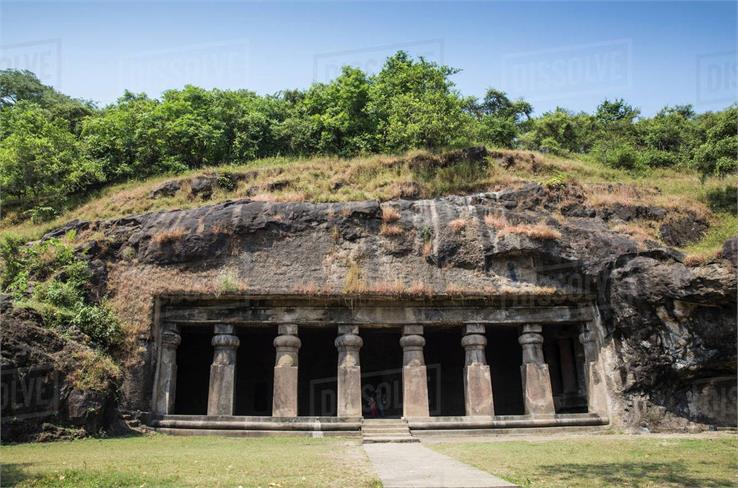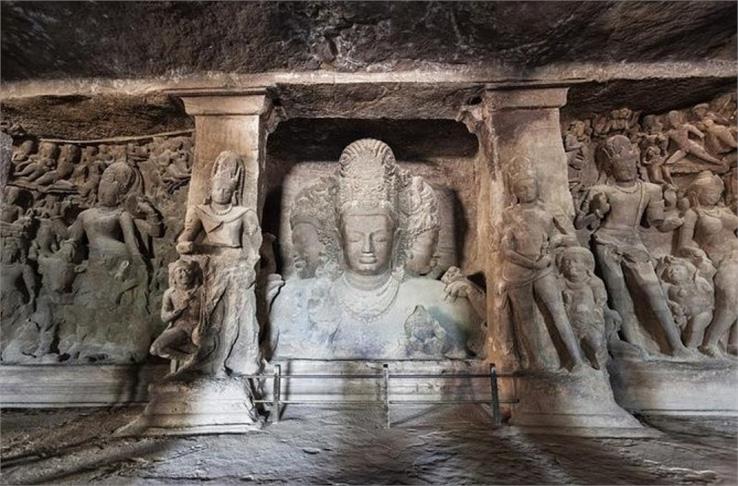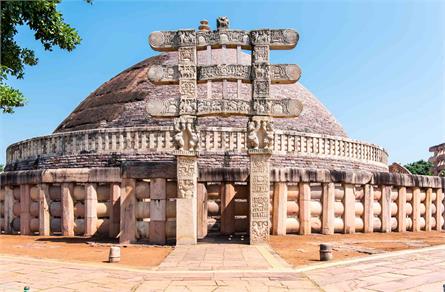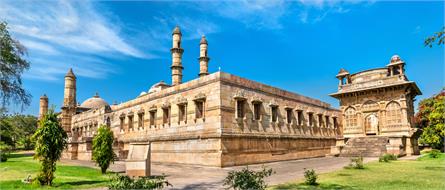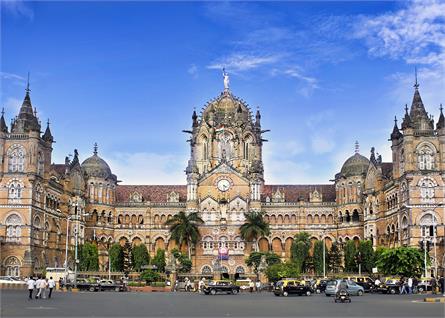"Elephanta Caves: The Ancient Legacy of India"

The Elephanta Caves, located on the picturesque Elephanta Island, Maharashtra in Western India, are a tribute to the area's rich cultural history. This archaeological marvel dates back to the 2nd century BC, with the rock-cut caves sculpted in the mid-5th to 6th centuries AD. These caves, most notably Cave 1, offer a mesmerizing blend of artistic beauty and spiritual significance with their intricate sculptures and unique architectural features.
Also Read: UNESCO World Heritage sites in India
Historical Significance of Elephanta Caves | Island caves near Mumbai
Elephanta Island, also known as the Island of Gharapuri, is not only a visual delight but also an archaeological treasure trove. The island's archaeological remains are a testament to centuries of occupation and cultural evolution, providing glimpses into the life and beliefs of ancient civilizations. The rock-cut Elephanta Caves, with their origins shrouded in history, are a pinnacle of artistic expression and spiritual devotion.
The history of the Elephanta Caves is shrouded in mystery and has been the subject of historical debate and archaeological investigation. The island itself has a rich cultural past dating back to possibly the 2nd century BC, with evidence of human settlement and the presence of Hinayana Buddhist activity.
Also Read: Agra Fort, India's Majestic Jewel of Mughal Architecture
The historical aspects of the Elephanta Caves based on the following aspects-
1. Ancient Settlement and Religious Transition
The island of Elephanta has a long history of human settlement, with early records suggesting the presence of Hinayana Buddhists on the island, possibly around the 2nd century BCE. It is believed that Buddhists initially occupied the site and raised a large stupa dedicated to the Buddha, surrounded by smaller stupas. This suggests a transition from Buddhism to Hinduism on the island.
2. Coins and Gupta Empire Era
Coins dating to the 4th century CE, from the Kshatrapas (Western Satraps), were found on the island, indicating continued activity. However, the regional history of the Elephanta Caves is not explicitly mentioned in the Gupta Empire records.
3. Disputed Origins and Dating
The exact origins and century in which the Elephanta Caves were built have been the subject of historic dispute. Various theories and hypotheses about their construction and dating have been put forth. Colonial-era historians initially suggested that the caves were built by the Rashtrakutas in the 7th century, but this theory has been discredited.
4. Religious and Mythological Context
The artwork and sculptures within the Elephanta Caves are deeply rooted in Hindu mythology, particularly focused on Lord Shiva. They reflect the influence of Vedic and post-Vedic religious thought on Hindu culture during the mid-1st millennium CE.
5. Historic Damage and Preservation
The Elephanta Caves endured damage and defacement during various periods, including the Sultanate rule and colonial Portuguese rule. The Portuguese ceded the island to the British in 1661. During the British colonial period, the caves saw further deterioration.
Also Read: Churches and Convents of Goa The UNESCO Heritage
Elephanta Caves architecture | Rock-cut sculptures in Elephanta
According to the Archaeological Survey of India and UNESCO, the caves were likely built between the 5th and 6th centuries. They represent a significant example of ancient Indian rock-cut architecture and sculpture. The completion of the temples is generally attributed to the mid-6th century and is associated with the Kalachuri dynasty, particularly King Krishnaraja.
The Elephanta Caves are a stunning example of Indian rock-cut art and architecture. These caves are expertly carved out of solid basalt rock, covering an impressive 60,000 square feet. In total, there are seven excavations within the Elephanta group, with five associated with Hinduism and two with Buddhism. The caves' layout is truly remarkable, featuring intricately designed pillars, a strategic division of the caves into various parts, and a garbhagriha of sarvatobhadra plan which provides a sacred space for worship. These architectural elements are significant developments in the world of rock-cut architecture.
Also Read: The Ancient Ruins of Dholavira & Harappan Civilization
The highlight of the Elephanta Caves is undoubtedly Cave 1, a vast expanse measuring 39 meters from the entrance to the back. This cave closely resembles the Dumar Lena cave at Ellora, showcasing the ingenuity of ancient Indian rock-cut architecture. The main body of the cave, supported by rows of six columns each, spans 27 meters square.
One of the most striking features of Cave 1 is the 7-meter-high masterpiece known as "Sadashiva." This awe-inspiring sculpture embodies three facets of Lord Shiva: the Creator, the Preserver, and the Destroyer. Each aspect is represented in one-half of the sculpture, symbolizing the dynamic nature of the divine.
Also Read: Chhatrapati Shivaji Terminus A Glimpse into Mumbai's Architectural and Historical Marvel
The cave is adorned with other remarkable sculptures, including representations of Nataraja, Yogishvara, Andhakasuravadha, Ardhanarishwara, Kalyanasundaramurti, Gangadharamurti, and Ravanaanugrahamurti. These sculptures not only dazzle with their artistry but also convey profound spiritual messages.
The layout of the caves, the placement of pillars, and the incorporation of a sanctum with a sarvatobhadra plan showcase the evolution of rock-cut architecture and its harmonious integration with Hindu spiritual beliefs and symbology.
Also Read: The Enigmatic Ajanta Caves: A Glimpse into India's Ancient Artistic Marvel
Restoration and UNESCO World Heritage Designation
In the late 1970s, the Government of India undertook restoration efforts for the main cave to make it a tourist and heritage site. The Elephanta Caves were designated a UNESCO World Heritage Site in 1987 due to their exceptional cultural and historical significance.
The site has since been protected and preserved to ensure its conservation for future generations.
Also Read: Champaner-Pavagadh: A Must-Visit Site For History And Architecture Lovers
Conservation and Preservation
Preserving the Elephanta Caves is paramount to ensure that future generations can witness this unparalleled cultural heritage. While the site has been well-maintained, specific challenges, such as saline activity and general rock surface deterioration, require attention.
To safeguard the Elephanta Caves, a Conservation Management Plan is essential. This plan would guide restoration and conservation efforts, addressing issues like rock surface deterioration and the need to dismantle and redo the restoration work in the 1960s. Additionally, protecting the caves from nearby industrial development and considering the exposure of buried stupas are crucial steps toward maintaining their authenticity and value.
Also Read: The Beauty of Buddhist Monuments Heritage At Sanchi
Tourist Destination
The Elephanta Caves are a popular tourist destination in Mumbai, drawing visitors from around the world. The caves can be reached by a ferry ride from the Gateway of India in Mumbai, making it a convenient day trip for tourists.
Also Read: Nalanda Mahavihara: The Ancient Seat of Learning in Bihar
Cultural Significance
The sculptures and artwork in the caves provide valuable insights into the religious and cultural practices of ancient India. They also depict various legends from Hindu mythology. The Elephanta Caves represent a unique historical and cultural site with a complex history of religious transitions, architectural brilliance, and periods of damage and restoration. Their dating to the mid-6th century CE and association with the Kalachuri dynasty adds to their historical importance. Today, they continue to attract visitors from around the world as a testament to India's rich heritage. The Elephanta Caves inspire awe and reverence, bridging the gap between the past and the present and inviting visitors to explore the rich tapestry of India's cultural heritage.
